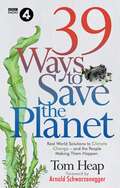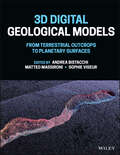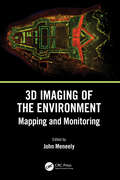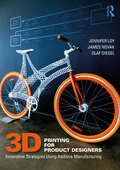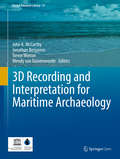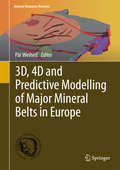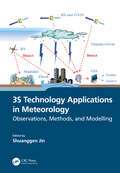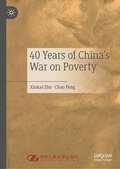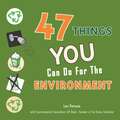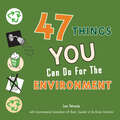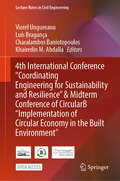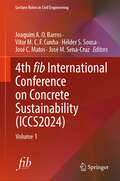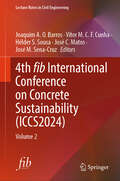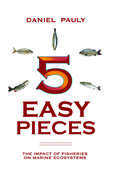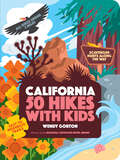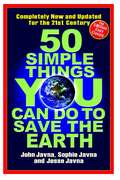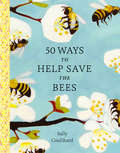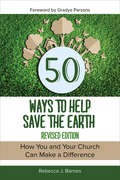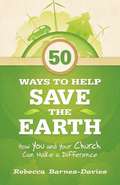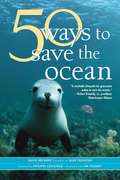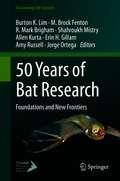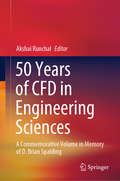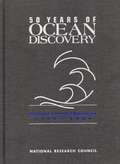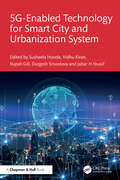- Table View
- List View
39 Ways to Save the Planet
by Tom HeapWe got ourselves into this. Here's how we can get ourselves out.We know the problem: the amount of biodiversity loss, the scale of waste and pollution, the amount of greenhouse gas we pump into the air... it's unsustainable. We have to do something. And we are resourceful, adaptable and smart. We have already devised many ways to reduce climate change - some now proven, others encouraging and craving uptake. Each one is a solution to get behind.In 39 Ways to Save the Planet, Tom Heap reveals some of the real-world solutions to climate change that are happening around the world, right now. From tiny rice seeds and fossil fuel free steel to grazing elk and carbon-capturing seagrass meadows, each chapter reveals the energy and optimism in those tackling the fundamental problem of our age. Accompanying a major BBC Radio 4 series in collaboration with the Royal Geographical Society, 39 Ways to Save the Planet is a fascinating exploration of our attempt to build a better future, one solution at a time. A roadmap to global action on climate change, it will encourage you to add your own solutions to the list.
3D Digital Geological Models: From Terrestrial Outcrops to Planetary Surfaces
by Andrea Bistacchi Matteo Massironi Sophie Viseur3D DIGITAL GEOLOGICAL MODELS Discover the practical aspects of modeling techniques and their applicability on both terrestrial and extraterrestrial structures A wide overlap exists in the methodologies used by geoscientists working on the Earth and those focused on other planetary bodies in the Solar System. Over the course of a series of sessions at the General Assemblies of the European Geosciences Union in Vienna, the intersection found in 3D characterization and modeling of geological and geomorphological structures for all terrestrial bodies in our solar system revealed that there are similar datasets and common techniques for the study of all planets—Earth and beyond—from a geological point-of-view. By looking at Digital Outcrop Models (DOMs), Digital Elevation Models (DEMs), or Shape Models (SM), researchers may achieve digital representations of outcrops, topographic surfaces, or entire small bodies of the Solar System, like asteroids or comet nuclei. 3D Digital Geological Models: From Terrestrial Outcrops to Planetary Surfaces has two central objectives, to highlight the similarities that geological disciplines have in common when applied to entities in the Solar System, and to encourage interdisciplinary communication and collaboration between different scientific communities. The book particularly focuses on analytical techniques on DOMs, DEMs and SMs that allow for quantitative characterization of outcrops and geomorphological features. It also highlights innovative 3D interpretation and modeling strategies that allow scientists to gain new and more advanced quantitative results on terrestrial and extraterrestrial structures. 3D Digital Geological Models: From Terrestrial Outcrops to Planetary Surfaces readers will also find: The first volume dedicated to this subject matter that successfully integrates methodology and applications A series of methodological chapters that provide instruction on best practices involving DOMs, DEMs, and SMs A wide range of case studies, including small- to large-scale projects on Earth, Mars, the 67P/Churyumov-Gerasimenko comet, and the Moon Examples of how data collected at surface can help reconstruct 3D subsurface models 3D Digital Geological Models: From Terrestrial Outcrops to Planetary Surfaces is a useful reference for academic researchers in earth science, structural geology, geophysics, petroleum geology, remote sensing, geostatistics, and planetary scientists, and graduate students studying in these fields. It will also be of interest for professionals from industry, particularly those in the mining and hydrocarbon fields.
3D Imaging of the Environment: Mapping and Monitoring
by John MeneelyThis is a comprehensive, overarching, interdisciplinary book and a valuable contribution to a unified view of visualisation, imaging, and mapping. It covers a variety of modern techniques, across an array of spatial scales, with examples of how to map, monitor, and visualise the world in which we live. The authors give detailed explanations of the techniques used to map and monitor the built and natural environment and how that data, collected from a wide range of scales and cost options, is translated into an image or visual experience. It is written in a way that successfully reaches technical, professional, and academic readers alike, particularly geographers, architects, geologists, and planners. FEATURES Includes in-depth discussion on 3D image processing and modeling Focuses on the 3D application of remote sensing, including LiDAR and digital photography acquired by UAS and terrestrial techniques Introduces a broad range of data collection techniques and visualisation methods Includes contributions from outstanding experts and interdisciplinary teams involved in earth sciences Presents an open access chapter about the EU-funded CHERISH Project, detailing the development of a toolkit for the 3D documentation and analysis of the combined coastline shared between Ireland and Wales Intended for those with a background in the technology involved with imaging and mapping, the contributions shared in this book introduce readers to new and emerging 3D imaging tools and programs.
3D Printing for Product Designers: Innovative Strategies Using Additive Manufacturing
by Olaf Diegel Jennifer Loy James Novak3D Printing for Product Designers closes the gap between the rhetoric of 3D printing in manufacturing and the reality for product designers. It provides practical strategies to support the adoption and integration of 3D printing into professional practice. 3D printing has evolved over the last decade into a practical proposition for manufacturing, opening up innovative opportunities for product designers. From its foundations in rapid prototyping, additive manufacturing has developed into a range of technologies suitable for end-use products. This book shows you how to evaluate and sensitively understand people, process, and products and demonstrates how solutions for working with additive manufacturing can be developed in context. It includes a practical, step-by-step plan for product designers and CEOs aimed at supporting the successful implementation of 3D printing by stakeholders at all levels of a manufacturing facility, tailored to their stage of technology integration and business readiness. It features a wide range of real-world examples of practice illustrated in full colour, across industries such as healthcare, construction, and film, aligning with the strategic approach outlined in the book. The book can be followed chronologically to guide you to transform your process for a company, to meet the unique needs of a specific client, or to be used as a starting point for the product design entrepreneur. Written by experienced industry professionals and academics, this is a fundamental reference for product designers, industrial designers, design engineers, CEOs, consultants, and makers.
3D Recording and Interpretation for Maritime Archaeology (Coastal Research Library #31)
by Jonathan Benjamin John K. McCarthy Trevor Winton Wendy Van DuivenvoordeThis open access peer-reviewed volume was inspired by the UNESCO UNITWIN Network for Underwater Archaeology International Workshop held at Flinders University, Adelaide, Australia in November 2016. Content is based on, but not limited to, the work presented at the workshop which was dedicated to 3D recording and interpretation for maritime archaeology. The volume consists of contributions from leading international experts as well as up-and-coming early career researchers from around the globe. The content of the book includes recording and analysis of maritime archaeology through emerging technologies, including both practical and theoretical contributions. Topics include photogrammetric recording, laser scanning, marine geophysical 3D survey techniques, virtual reality, 3D modelling and reconstruction, data integration and Geographic Information Systems. The principal incentive for this publication is the ongoing rapid shift in the methodologies of maritime archaeology within recent years and a marked increase in the use of 3D and digital approaches. This convergence of digital technologies such as underwater photography and photogrammetry, 3D sonar, 3D virtual reality, and 3D printing has highlighted a pressing need for these new methodologies to be considered together, both in terms of defining the state-of-the-art and for consideration of future directions. As a scholarly publication, the audience for the book includes students and researchers, as well as professionals working in various aspects of archaeology, heritage management, education, museums, and public policy. It will be of special interest to those working in the field of coastal cultural resource management and underwater archaeology but will also be of broader interest to anyone interested in archaeology and to those in other disciplines who are now engaging with 3D recording and visualization.
3D, 4D and Predictive Modelling of Major Mineral Belts in Europe (Mineral Resource Reviews)
by Pär WeihedThis book presents the results of the major EU project Promine. For the first time there is now a European database available on mineral deposits, as well as 3D, 4D and predictive models of major mineral belts in Europe: Fennoscandia (Skellefteå and Vihanti-Pyhäsalmi), the Fore-Sudetic basin (Kupferschiefer deposits in Poland and Germany), the Hellenic belt in northern Greece, and the Iberian Pyrite belt and Ossa Morena zone in Spain and Portugal. The book also describes the modelling techniques applied and how different types of software are used for three- and four-dimensional modelling. Furthermore, fundamental descriptions of how to build the database structure of three-dimensional geological data are provided and both 2D and 3D predictive models are presented for the main mineral belts of Europe.
3S Technology Applications in Meteorology: Observations, Methods, and Modelling
by Shuanggen JinSpatial information technology and its integration, such as remote sensing, geographic information systems (GIS), and global navigation satellite systems (GNSS), known as 3S technology, have been extensively utilized in managing and monitoring natural disasters. This book illustrates the 3S integrated applications in the field of meteorology and promotes the role of 3S in developing precise and intelligent meteorology. It presents the principles of 3S technology and the methods for monitoring different meteorological disasters and hazards as well as their application progress. The case studies from the United States, Japan, China, and Europe were conducted to help all countries understand the 3S technology functions in handling and monitoring severe meteorological hazards. FEATURES Presents integral observations from GNSS, GIS, and remote sensing in estimating and understanding meteorological changes Explains how to monitor and retrieve atmospheric parameter changes using GNSS and remote sensing Shows three-dimensional modelling and evaluations of meteorological variation processing based on GIS Helps meteorologists develop and use space-air-ground integrated observations for meteorological applications Illustrates the practices in monitoring meteorological hazards using space information techniques and case studies This book is intended for academics, researchers, and postgraduate students who specialize in geomatics, atmospheric science, and meteorology, as well as scientists who work in remote sensing and meteorology, and professionals who deal with meteorological hazards.
40 Years of China's War on Poverty
by Xinkai Zhu Chao PengChina's anti-poverty campaign has liberated hundreds of millions of citizens from absolute poverty, offering a compelling model for other developing countries around the world. This book demonstrates the path of China’s poverty alleviation and explores the approach and the theory underlying the country’s experience. The authors elucidate four important stages of poverty alleviation in China. They further investigate how the administration has balanced economic growth, regional development and the protection of ecosystem and cultural and heritage sites during China's remarkable transformation. As China’s development experience have extended the theory of international poverty alleviation, this book should provide valuable insights and offer enlightenment to global scholars, NGOs and governments of other developing countries.
47 Things Teens Can Do for the Environment
by Lexi Petronis Jill BuckSure, we all know the planet is in trouble. We hear talk all the time about climate change, air pollution from cars, oil spills into oceans, trash overflowing into waterways, and toxic chemicals leaking into our groundwater. Sigh. But the good news is there's a lot we can do to start cleaning up the Earth. And it starts with you! This book explores tons of small (and big) things that teens can do to make a positive difference in the environment such as: * go on a green date with a new crush * eat less meat * learn to shop vintage * create an environmental task force at school * go on an eco-adventure * and more!
47 Things You Can Do for the Environment
by Lexi Petronis Jill BuckSure, we all know the planet is in trouble. We hear talk all the time about climate change, air pollution from cars, oil spills into oceans, trash overflowing into waterways, and toxic chemicals leaking into our groundwater. Sigh. But the good news is there’s a lot we can do to start cleaning up the Earth. And it starts with you!
4th International Conference "Coordinating Engineering for Sustainability and Resilience" & Midterm Conference of CircularB “Implementation of Circular Economy in the Built Environment” (Lecture Notes in Civil Engineering #489)
by Viorel Ungureanu Charalambos Baniotopoulos Luís Bragança Khairedin M. AbdallaThis open access book gathers the proceedings of the 4th International Conference “Coordinating Engineering for Sustainability and Resilience” (CESARE) & Midterm Conference of CircularB “Implementation of Circular Economy in the Built Environment”, held in Timișoara, Romania, on May 29-31, 2024, as part of the COST Action CA21103. The volume represents the state of the art of sustainability and resilience in modern and future built environment, constructions, and infrastructure, and includes topics such as structural materials and robustness, fire engineering, risk assessment, impact of climate change on the built environment, sustainable resilience of systems in the built environment, smart cities, circular economy, design strategies for product design, integration of renewable energy at building and small urban area scales, restoration & rehabilitation of historical buildings, sustainable infrastructures, wind energy structures, façade engineering, green buildings, and waste management.
4th fib International Conference on Concrete Sustainability: Volume 1 (Lecture Notes in Civil Engineering #573)
by José C. Matos Hélder S. Sousa Vítor M. C. F. Cunha Joaquim A. O. Barros José M. Sena-CruzThis volume presents the proceedings of the fib International Conference on Concrete Sustainability, held in Guimarães, Portugal on 11–13 September 2024. It covers topics such as concrete and advanced materials, structural performance and design, construction methods and management, durability, life cycle design, through-life management and care, resilience, dismantlement, reuse and recycling, & innovation in buildings and civil structure. fib (The International Federation for Structural Concrete) is a not-for-profit association whose mission is to develop at an international level the study of scientific and practical matters capable of advancing the technical, economic, aesthetic, and environmental performance of concrete construction.
4th fib International Conference on Concrete Sustainability: Volume 2 (Lecture Notes in Civil Engineering #574)
by José C. Matos Hélder S. Sousa Vítor M. C. F. Cunha Joaquim A. O. Barros José M. Sena-CruzThis volume presents the proceedings of the fib International Conference on Concrete Sustainability, held in Guimarães, Portugal on 11–13 September 2024. It covers topics such as concrete and advanced materials, structural performance and design, construction methods and management, durability, life cycle design, through-life management and care, resilience, dismantlement, reuse and recycling, & innovation in buildings and civil structure. fib (The International Federation for Structural Concrete) is a not-for-profit association whose mission is to develop at an international level the study of scientific and practical matters capable of advancing the technical, economic, aesthetic, and environmental performance of concrete construction.
5 Easy Pieces: The Impact of Fisheries on Marine Ecosystems
by Daniel Pauly5Easy Pieces features five contributions, originally published in Nature and Science, demonstrating the massive impacts of modern industrial fisheries on marine ecosystems. Initially published over an eight-year period, from 1995 to 2003, these articles illustrate a transition in scientific thought--from the initially-contested realization that the crisis of fisheries and their underlying ocean ecosystems was, in fact, global to its broad acceptance by mainstream scientific and public opinion. Daniel Pauly, a well-known fisheries expert who was a co-author of all five articles, presents each original article here and surrounds it with a rich array of contemporary comments, many of which led Pauly and his colleagues to further study. In addition, Pauly documents how popular media reported on the articles and their findings. By doing so, he demonstrates how science evolves. In one chapter, for example, the popular media pick up a contribution and use Pauly's conclusions to contextualize current political disputes; in another, what might be seen as nitpicking by fellow scientists leads Pauly and his colleagues to strengthen their case that commercial fishing is endangering the global marine ecosystem. This structure also allows readers to see how scientists' interactions with the popular media can shape the reception of their own, sometimes controversial, scientific studies. In an epilog, Pauly reflects on the ways that scientific consensus emerges from discussions both within and outside the scientific community.
50 Hikes with Kids California: California (50 Hikes With Kids Ser.)
by Wendy GortonA Love of Nature Starts Here! California kids live in a magnificent natural playground, and 50 Hikes with Kids California helps them explore its beaches, deserts, mountains, and forests. Scavenger hunts for every hike make it fun for families to learn about the region’s geology, flora, and fauna. For successful adventures with even the youngest trekkers, award-winning author Wendy Gorton includes a detailed map, trustworthy and intuitive directions, a difficulty rating, restroom info, and places to grab a snack nearby for every trip.
50 Simple Things You Can Do to Pave the Earth
by Darryl Henriques50 things you can do to eliminate your carbon footprint.
50 Simple Things You Can Do to Save the Earth: Completely New and Updated for the 21st Century
by John JavnaTogether, We Can Make a DifferenceToday's environmental problems may seem too overwhelming for one person to tackle . . . but you don't have to do it alone. Now you have partners--50 of them.50 Simple Things You Can Do to Save the Earth, the revolutionary 1990 bestseller, is back in a completely revised, updated edition . . . and it's just as innovative and groundbreaking as the original. The authors have teamed up with 50 of America's top environmental groups, including The Natural Resources Defense Council, the National Wildlife Federation, and Rainforest Action Network. Each group has chosen one issue and provided a simple, step-by-step program that will empower you and your family to become citizen activists in the fight to save the Earth.It's easy to get started. Just pick one! Fight global warming "one city at a time" with the Sierra Club's Cool Cities Campaign Roll up your sleeves and save an endangered species with the Wilderness Society Protect coral reefs and create a marine reserve with Seacology Get your congregation excited about protecting God's creations with Interfaith Power and Light Invite songbirds into your neighborhood with the National Audubon SocietyAll it takes is a little effort. When we work together, we can work miracles! Get started now!
50 Ways to Help Save the Bees
by Sally CoulthardHave you heard the buzz? Bees—the tiny insects that pollinate nearly all our fruits and vegetables—need our support. If you like to eat your fruits and vegetables (and even if you don’t!), you should value our planet’s bees. Yet, because of environmental pollution, loss of green spaces, and a general disregard for the well-being of insects, humans have caused the number of bees to plummet. In the past year, the managed honeybee population of the United States has dropped 40 percent, and there has been a 25 percent decline in wild bees—figures that are alarming at best. Helping the bees is easier than you might imagine, however, as outlined in this charmingly illustrated call to action. Here are 50 easy suggestions, along with an informative introduction, to get you started. Try cutting your lawn less frequently, buying ethical honey, and keeping your yard dark at night. You can follow easy instructions for building a bee-friendly window box or a green-roofed garden shed. Little things can make a big difference. Just ask a bee.
50 Ways to Help Save the Earth: How You And Your Church Can Make A Difference
by Rebecca J. BarnesThis guide outlines fifty ways in which you, your congregation, and your local community can help fight global warming and enjoy participation in a vital part of Christian discipleship. 50 Ways to Help Save the Earth makes a clear connection, in a practical and unintimidating way, between stewardship of the earth and living one's faith. <p><p> This easy-to-follow book consists of seven chapters on topics related to global climate change: "Water," "Energy," "Transportation," "Food and Agriculture," "People," "Other Species," and "Wilderness and Land." Each chapter begins with a statement on how the content relates to global warming, followed by seven action items ranging from individual efforts to activities that encourage the involvement of the congregational and wider communities.
50 Ways to Help Save the Earth: How You and Your Church Can Make a Difference
by Rebecca J. Barnes-DaviesThis guide outlines fifty ways in which you, your congregation, and your local community can help fight global warming and enjoy participation in a vital part of Christian discipleship. 50 Ways to Help Save the Earth makes a clear connection, in a practical and unintimidating way, between stewardship of the earth and living one's faith. This easy-to-follow book consists of seven chapters on topics related to global climate change: "Water," "Energy," "Transportation," "Food and Agriculture," "People," "Other Species," and "Wilderness and Land." Each chapter begins with a statement on how the content relates to global warming, followed by seven action items ranging from individual efforts to activities that encourage the involvement of the congregational and wider communities.
50 Ways to Save the Ocean
by David HelvargThe book focuses on practical, easily-implemented actions everyone can take to protect and conserve the vital resource of Ocean. The book addresses daily choices that affect the ocean's health: what fish should and should not be eaten; how and where to vacation; storm drains and driveway run-off; protecting local water tables; proper diving, surfing, and tidepool etiquette; and supporting local marine education.
50 Years of Bat Research: Foundations and New Frontiers (Fascinating Life Sciences)
by M. Brock Fenton Amy Russell Jorge Ortega Allen Kurta Burton K. Lim R. Mark Brigham Shahroukh Mistry Erin H. GillamWith more than 1,400 species, bats are an incredibly diverse and successful group of mammals that can serve as model systems for many unique evolutionary adaptations. Flight has allowed them to master the sky, while echolocation enables them to navigate in the dark. Being small, secretive, nocturnal creatures has made bats a challenge to study, but over the past 50 years, innovative research has made it possible to dispel some of the mystery and myth surrounding them to give us a better understanding of the role these animals play in the ecosystem. The structure of the book is based on several broad themes across the biological sciences, including the evolution of bats, their ecology and behavior, and conservation of biodiversity. Within these themes are more specific topics on important aspects of bat research, such as morphology, molecular biology, echolocation, taxonomy, systematics, threats to bats, social structure, reproduction, movements, and feeding strategies. Given its scope, the book will appeal to the wider scientific community, environmental organizations, and government policymakers who are interested in the interdisciplinary aspects of biology and nature.
50 Years of CFD in Engineering Sciences: A Commemorative Volume in Memory of D. Brian Spalding
by Akshai RunchalProf. D. Brian Spalding, working with a small group of students and colleagues at Imperial College, London in the mid-to late-1960’s, single-handedly pioneered the use of Computational Fluid Dynamics (CFD) for engineering practice.This book brings together advances in computational fluid dynamics in a collection of chapters authored by leading researchers, many of them students or associates of Prof. Spalding. The book intends to capture the key developments in specific fields of activity that have been transformed by application of CFD in the last 50 years. The focus is on review of the impact of CFD on these selected fields and of the novel applications that CFD has made possible. Some of the chapters trace the history of developments in a specific field and the role played by Spalding and his contributions. The volume also includes a biographical summary of Brian Spalding as a person and as a scientist, as well as tributes to Brian Spalding by those whose life was impacted by his innovations. This volume would be of special interest to researchers, practicing engineers, and graduate students in various fields, including aerospace, energy, power and propulsion, transportation, combustion, management of the environment, health and pharmaceutical sciences.
50 Years of Ocean Discovery: National Science Foundation 1950--2000
by National Research Council Staff Ocean Studies Board StaffThis book describes the development of ocean sciences over the past 50 years, highlighting the contributions of the National Science Foundation (NSF) to the field's progress. Many of the individuals who participated in the exciting discoveries in biological oceanography, chemical oceanography, physical oceanography, and marine geology and geophysics describe in the book how the discoveries were made possible by combinations of insightful individuals, new technology, and in some cases, serendipity.In addition to describing the advance of ocean science, the book examines the institutional structures and technology that made the advances possible and presents visions of the field's future. This book is the first-ever documentation of the history of NSF’s Division of Ocean Sciences, how the structure of the division evolved to its present form, and the individuals who have been responsible for ocean sciences at NSF as “rotators” and career staff over the past 50 years.
5G Enabled Technology for Smart City and Urbanization System
by Susheela Hooda Durgesh Srivastava Jabar H. Yousif Vidhu Kiran Rupali GillThis book examines the applications, trends and challenges of 5G Enabled technologies for Smart City and Urbanization systems. It addresses the challenges to bringing such capabilities of 5G-enabled technologies for smart cities and urbanisation into practice by presenting the theoretical as well as technical research outcomes with case studies. It covers key areas, including smart building, smart health care, smart mobility, smart living, smart surveillance, and IOT-based systems. It explains how these systems are connected using different technologies that support 5G access and control protocols.• Offers a comprehensive understanding of the emergence of 5G technology and its integration with IoT, Big Data, and Artificial Intelligence for smart city and urbanisation• Focuses on useful applications of Smart City and Urbanization, which can enhance different aspects of urban life• Explores the advantages of using massive IoT and predictive analytics approaches in smart cities• IoT, Bigdata, Deep learning and machine learning techniques are explained to fuel smart city and Urbanization system• Addresses both theoretical and technical research outcomes related to smart city and urbanisation with 5G technology.It serves as a valuable reference for graduate students, researchers, and m practitioners seeking to deepen their knowledge and engage with the latest advancements in the areas of Smart cities and Urbanization systems.
